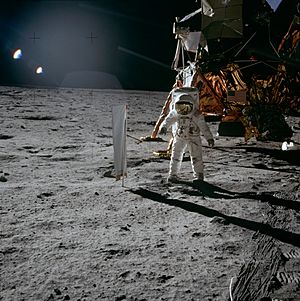Solar Wind Composition Experiment facts for kids

The Solar Wind Composition Experiment (SWC) was a special test done on the Moon during the Apollo program. It happened on Apollo missions 11, 12, 14, 15, and 16. The main goal was to measure the solar wind far away from Earth's protective magnetosphere. This experiment was the first time scientists could properly measure different types of solar material, called isotopes, directly from the sun.
Contents
What Was the Solar Wind Experiment?
The Solar Wind Composition Experiment, or SWC, was a simple but very important science project. It helped us learn more about the sun and the tiny particles it sends out. These particles are known as solar wind.
Why Study Solar Wind?
The sun constantly sends out a stream of tiny charged particles. This is called the solar wind. On Earth, we are protected from most of this wind by our planet's magnetosphere. This is like a giant magnetic shield around Earth. To truly understand the solar wind, scientists needed to measure it where Earth's shield wasn't in the way. The Moon was the perfect place for this. Studying the solar wind helps us understand how the sun works and how it affects space around us.
Who Created the Experiment?
The idea for the SWC experiment came from a team of Swiss scientists. Professor Johannes Geiss from the University of Bern led this team. Peter Eberhardt from the Swiss Institute of Technology was also a key part of it. The government of Switzerland helped pay for some of the experiment. This shows how countries worked together on the Apollo missions.
How Did the Experiment Work?
The experiment was quite clever and simple. Astronauts on the Moon set up a special sheet made of aluminum. They pointed this sheet directly towards the sun. As the solar wind blew past the Moon, tiny charged particles, called ions, hit the aluminum sheet. These particles then got stuck on the foil. After the experiment was finished, the astronauts carefully folded the sheet. They placed it inside a special bag made of Teflon. Then, they brought the sheet back to Earth.
What Did Scientists Discover?
Once the aluminum sheets were back on Earth, scientists studied them very closely. They found that the experiment was a big success! The sheets had collected different types of particles from the sun. Scientists were able to identify the Helium, Neon, and Argon isotopic compositions. This means they found different forms of these elements that came directly from the sun. These discoveries gave us new information about what the sun is made of. It also helped us understand how the solar wind carries these materials through space.
See also
 In Spanish: SWCE para niños
In Spanish: SWCE para niños

